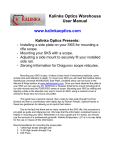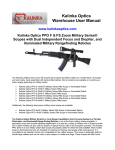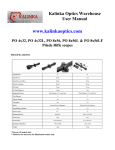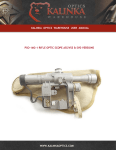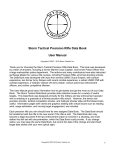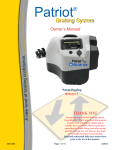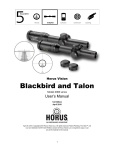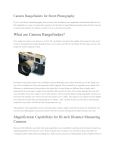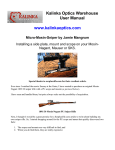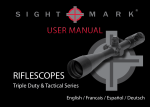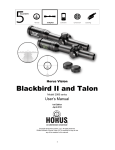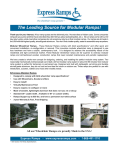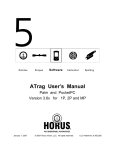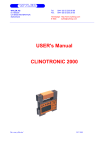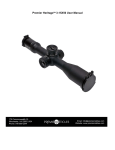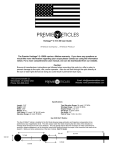Download Kalinka Optics Warehouse User Manual www.kalinkaoptics.com
Transcript
2. 3. 4. 5. 6. Include a note with your name, address, telephone number, email, and a description of the problem. Pack the scope securely using proper packing materials. Ship the scope (insured if possible) by parcel or mail service with delivery confirmation. If the date of sale can not be determined the warranty period assumed to begin at the date of manufacture of the scope. If maintenance or feasible and justifiable repairs have to be done upon expiration of the warranty period, all costs related to these services are the responsibility of the customer. Kalinka Optics Warehouse – Your Best Choice for the Finest in Optics and Accessories! Kalinka Optics Warehouse User Manual www.kalinkaoptics.com PO Fixed Magnification Rifle Scope Manual Thanks for Shopping with US! WWW.KALINKAOPTICS.COM 12 We thank you for purchasing a quality rifle scope from Kalinka Optics Warehouse®. We carry and produce only the finest rifle scopes. While there are several companies in the world that make quality scopes, only ours combine professional performance without breaking the bank. The only thing better than owning a world-class instrument is owning one inexpensively. Our scopes are based on Soviet military designs, which are extremely rugged and have the very best optical properties. The advanced technologies used in crafting these fine scopes are based on the groundbreaking work of the Carl Zeiss-Jena factory in Jena, Germany which was captured by the US & Soviet armies during World War II. The Zeiss-Jena factory and its trove of advanced physics and engineering technology was literally disassembled and taken to the Soviet Union at the end of the war. Additional Zeiss factories located in the Baltics and other Eastern Bloc countries were taken over by the Soviet military machine. Thus, our scopes come from a handful of small, private factories with a rich tradition of producing fine optics for the Soviet and Russian military. The optics sold here are of the highest quality for military, law enforcement and sporting use. Compare their performance and price with Leupold and other top brands. The optics are very clear and come in a variety of styles, magnifications and wit h many different reticles to suit every purpose. Know Your Scope Rifle scopes have seen great advances over the last half century. However the major optical parts are still the same: 1. Objective lens – The front lens which provides clarity and light gathering ability. 2. Inverting lens – Also known as the internal erector lenses. 3. The reticle – The cross hairs which provide the aim point and are often designed to find your range to target. Russian rangefinding reticles on both the 1000 meter Dragunov and 400 meter Simonov reticles are measured in equal amounts of MOA (minutes of angle, ~1inch at 100 yards), either range-finding reticle can be used effectively with any caliber of weapon. 2 1. 2. 3. 4. 5. Check the mount. Make sure the scope is mounted securely to the rifle. Try, with bare hands only, to twist the scope in the rings or see if anything moves when pressure is applied. Make sure the action of your rifle is properly bedded in the stock and that all receiver screws are tight and have been tightened in the sequence recommended by the manufacturer. A loosely fitted stock can cause changes in the point of impact. When test firing a rifle to check the point of impact relative to windage and elevation adjustments, be sure to fire from a solid bench with sandbags supporting the forearm and butt stock. Be sure to use factory-loaded ammunition of the same bullet type, weight and lot number. If one type of ammunition does not shoot well, try another brand or bullet weight. Be certain that both the barrel and chamber are clean. Heavy factory grease on a new rifle and copper fouling on an older one can diminish the accuracy of the firearm. SAFEKEEPING Avoid hard strikes to the scope or dropping it. After using the scope in wet conditions wipe it with a dry, soft cloth and leave it to dry out at temperatures not exceeding 112 F°. To protect the glass surfaces of the scope always use the objective lens and eyepiece cups when the scope is not in use. When not in use, keep the scope in a dry place at room temperature with humidity not exceeding 80%. NEVER ATTEMPT TO FIX THE SCOPE YOURSELF OR TAKE IT APART FOR ANY REASON. VIOLATION WILL VOID THE WARRANTY. WARRANTY The scope meets or exceeds the quality standards set forth by the manufacturer and its technical specifications match those listed in this manual. The scope carries a 12 months limited warranty against manufacturing defects from the date of sale. If the scope fails during the warranty period the customer is entitled to have the scope repaired of fixed at the desecration of the dealer or the manufacturer. Each party is responsible for shipping costs of the scope at their end. The scope must be shipped to Kalinka Optics as outlined by their Warrant & Return policy which is available for viewing on the website, www.kalinkaoptics.com. Please follow these instructions in accordance to the policies listed online: 1. Remove the rings and any other accessories from the scope. 11 4. For German Post and Duplex Reticles Both reticles will fit a 70 cm (.77 yards) long target within the two side pickets at 100 meters. If the same size target is twice the width of the open space between the pickets then you can estimate its distance at 50 meters. Conversely, if that same target only fills half the open space, its distance would be 200 meters. For MilDot Reticles Range estimating with the Mil Dot Reticle , with practice, is simple. Dots are spaced in one mil (milliradian) increments on the crosshair. Using the mil formula, a table can be created that is based on the size of the object being targeted. Just look through the scope, bracket the object between dots, and refer to the table for an estimated distance to target. MAINTENANCE Our scope lenses are coated to reduce light reflections and light scattering thus increasing light transmission through the scope. They should be cleaned as carefully as you would a camera lens. For optimal cleaning use a special glasses or lenses lint-free cleaning cloth. When cleaning, use a standard lens brush to remove dust and then wipe with the cleaning cloth. The windage and elevation adjustments as well as the focusing ring are permanently lubricated. There is no need to lubricate any part of your scope. Our scopes are made of advanced alloys which require no other care then to be wiped down after use with a clean, dry cloth. TROUBLE SHOOTING TIPS If you are having a problem with your scope, try these tips. 10 Eyepiece. The ocular lens works in tandem with the other lenses to provide the correct magnification, gives you proper eye relief (how far away you can place your eye from the scope and see the full image, and make diopiter (focus) corrections. The inverting lens system transfers the image and reticule onto the focal plane of the eyepiece and at the same time inverts the image. The user sees the directly magnified view of the image and the reticule. Our scopes are parallax-free which means that the reticule won’t appear to be shifted related to the target once the user changes its position relative to the optical axis of the scope for magnifications of 7x or less. In higher magnification ranges parallax is set to a particular distance, usually 100 yards. Many models have a separate parallax focusing ring on the front objective. Many models also offer a binocular-style ocular focusing ring. Use it to get a sharper image by adjusting the focus to meet the needs of your eyesight. Once set to the desired position the setting can be secured by the locking nut. INTRODUCTION • Please Read This Entire Manual Before Mounting Your Scope! • Our rifle scopes are designed to assist in aiming at distant targets and can be mounted onto any hunting or assault rifle regardless of caliber. Models designated with an “L” or an “S” have an illuminated reticule for target acquisition in low light conditions. • The scope can be mounted onto a weapon using 1” or 30 mm mounting rings or adapters depending on the tube width. A solid mount is critical to proper performance of your scope. Our scopes are easily mountable to any weapon that takes Weaverstyle rings, Ruger rings, Dovetail rings or other standard rings. The dimensions of each scope are shown on the on-line item page so you can be sure of whether proper ring placement is possible for your specific rifle. Kalinka Optics Warehouse® carries a broad selection of mounting platforms, rings and other accessories. Take a look through our accessories section or contact us for the mounting accessories necessary for your KO scope. • The reticule can be adjusted in any direction as needed during sighting. The reticule is adjusted by using windage and elevation turrets. Windage and elevation turrets have scaled cams to assist you during the sighting process. The value of each click varies by the type of the scope. • As opposed to Chinese and other scopes from low-quality/lowcost countries, our scopes allow for more precise long distance 3 • • • shooting, as they are parallax free, meaning that your target does not float around as you move/adjust the angle of your eye. All reticules available have range-finding capability. The German Post and Duplex reticles can fit a 1/2 yard target between the side pickets at 100 yards while the metered reticles such as the Dragunov and Simonov provide full range-finding capability for multiple -sized targets. The 1000 meter Dragunov military reticle has an extremely effective and useful height-based rangefinder for dual use, with graduated scales for both standing and prone figure estimation. It includes extended distance inverted chevrons providing aiming points for 1000, 1100, and 1200 meters. The 400 meter Simonov military reticle also has a rangefinder for dual use. It includes extended distance inverted chevrons providing aiming points for 200, 300, and 400 meters. Since the range calibrations are measured in equal amounts of MOA for both rangefinders, these reticles can be used effectively with any caliber of weapon. All of our scopes are dry nitrogen purged to minimize fogging in wet conditions. The scope can be used in various climate conditions from -50F° to +110 F°. Scope Click Value PO scopes with 6x mag or lower 1 MOA @ 100 yards PO scopes with 8x mag or higher 1.2 MOA @ 100 yards Parallax settings on scopes 8x magnification and higher are set at 100 meters. For the 1000 meter reticle: For the 400m reticle: To set aiming angles correctly during the sighting process you’ll need to know the ballistics of your ammo or determine it by experimentation. OPERATION Mounting the Scope The scope can be mounted on the gun using 1” mounting rings or adapters that accept scopes with 1” tube. You should determine which rings or adapter is required to mount the scope on your gun as all guns have specific mounting options. Keep in mind that accuracy of your scope depends on how well the scope is bore sighted on your gun and the quality of the mount being used. Choose the mounting option that will hold the scope securely and won’t be compromised by recoil. Be sure to use mounts that are tall enough to clear the front objective bell of the scope from hitting the barrel. The lower the scope, the better. For most shooters, a lower scope provides better cheek weld on the stock for a stable firing position and allows for rapid target acquisition. However, 4 9 position. the height of the scope is purely shooter preference. Aiming and shooting at moving targets While shooting at moving targets it is necessary to aim ahead of the target. To determine how far the aiming point has to be taken out you’ll need to estimate the speed of the target and the distance to it. The faster the target moves and the further the distance to it the further ahead you’ll have to aim. Have the moving target aligned with horizontal hairs of the reticule as you aiming. Illuminated Reticle On items with an illuminated reticle, you will need a 3V power supply. Power supply for your scope is listed in the tech table online. All scopes take one of the following: 2 x D-357 small button batteries or 1 x CR2032 flat lithium battery. You can tell the type of batteries necessary by the battery well. If it is narrow and deep then it takes D-357, if it is shallow and wide then you need the CR2032. Note that the Pilade series takes 2 x LR43. All batteries are available online at www.kalinkaoptics.com or most anyplace where watch & electronics batteries are sold RETICULE Rangefinder The rangefinder works by placing the target (1.7 m or 5’8” in height) between the horizontal and the top reclining lines with the numbers. On the reclining line locate the number closest to the point where the target touches the line. Multiply that number by 100; this is the distance to the target in meters. 1 meter = 1.11 yards. Windage scale / rangefinder Windage scale can be used to make horizontal adjustments or as a rangefinder. Shifting the aiming point by one division left or right will move the point of impact by 10cm / 4” for every 100m / 333 ft of the distance. The distance to the target can be determined by assuming that a 1m / 3’4” wide/long object fits between the small divisions at 100 m / 333 ft. Aiming chevrons The chevrons are designed to adjust for bullet drop of ANY caliber, provided you know the ballistics of the ammo. If the top chevron is zeroed at 100 yards, aiming with 2nd, 3rd and the 4th will drop the aiming point by 1.2”, 2.5” and 4” accordingly for each 100 yards of the distance. Diopiter Adjustment (Focus Ring) Many models have a binocular-style diopiter adjustment from –3 to +3 D. To adjust the scope to your eyesight release the locking ring by turning it, adjust the eyepiece and tightly secure the locking ring. Eye Relief Because of the safety considerations associated with proper eye relief we recommend that you mount your scope as far forward as possible. With the scope as far forward as possible hold the rifle in your normal shooting position. Variable power scopes should be set at the highest magnification for this process. Slowly move the scope back towards you until you can comfortably see the full field-of-view while in a shooting position. Position your scope here for maximum eye relief. It is always helpful to take a shooting position in the kneeling, seated, prone and upright positions both uphill and downhill to ensure the best mounting position for proper eye relief. Be aware that if a scope is mounted too far to the rear, the eyepiece can injure the shooter’s brow. Shooting at an uphill angle also increases this hazard because it shortens the distance between the brow and the rear of the scope. Sighting and Zeroing the Scope IMPORTANT! Before mount-firing the scope, remove the windage and the elevation turret covers. Tightly secure the gun at the firing station using sand bags or special sighting rack to avoid shooter related inaccuracy. After trial shots (4-5) have been made, adjust the reticule position using the windage and the elevation turrets to reflect the average striking point. One or two shots may deviate from the shot group, this is normal, disregard those shots, and make adjustments based on the concentrated group of shots. After the reticule has been adjusted to deliver reasonable firing accuracy you’ll need to set the scale on the elevation and the windage turrets back to the “0” position without 8 5 actually changing the set windage and elevation settings. To do so release the two top screws and very carefully, without turning the turrets, adjust the scale (little top disk ONLY) by aligning the “0” mark on the scale with fixed mark on the scope. Tighten the screws and put the turret covers back on, you are done. The scope is ready for use. ATTENTION: The adjustment range for the windage and the elevation turrets may exceed one full turn in either direction resulting in having the scope being set to false “0”. In this case the reticule will be significantly shifted off the center and won’t represent the actual results of sighting. To avoid this, refrain from excessively turning the turrets. Sighting and Zeroing the Scope in Greater Depth While aiming you must put your eye on the optical axis of the scope so the image appears flat and without shadows at the edges. Using the soft rubber eyepiece available with most models will help you to properly align your eye to the optical axis and ensure the proper eye relief. If included, use the rubber sunshade for shooting in bright daylight conditions to prevent sunshine directly striking the objective lens causing excessive glare. The first step is to ensure that the rifle is zeroed with the iron sights. Also this process is much easier with little wind effects so do this on a day that isn't windy if possible. Set up the rifle on a firm and solid base and aim at a target with the iron sights at a distance of 50 meters. Zero the scope at 50 meters or 100 meters by using the scope. Set the windage to "0". Now see if the aiming reticle is lined up with the target. If it is, then your sight is considered an adjusted one. If it is not in line then rotate the dials (range and/or windage as necessary) to bring the reticle onto the target. At this point if you have to reset your dials so that they show ‘0’ when you are zeroed for a target 50 meters away without changing the position of the aiming reticle. To move the reticle to the shot (assuming you can keep the rifle in the same position as you make adjustments - otherwise trial and error will do the same thing...just take more ammo) you have to loosen the two screws on the top of each dial. Loosen the screw but do not remove them. As an example we will walk through the above example. We need to move the reticle over to the right since the rifle is hitting to the right. Rotate the windage dial clockwise until the reticle is approximately under the bullet hole when looking through the scope (make sure the silver part of the dial with the numbers on it does not move (I had to hold the range dial with pliers)). If you have to pick up the rifle to do this or otherwise can't keep it on target you will have to do guess work when moving the reticle. This may cause you to overcompensate but several iterations of firing and adjusting should zero the rifle. Then rotate the range dial counterclockwise to raise the reticle. Once you believe that you are close to where the bullet hit, screw the silver screws back in and repeat firing the rifle. Repeat this process until the rifle is zeroed. Aiming and shooting at fixed targets. Adjust the elevation turret or chose the appropriate chevron with respect to the range to the target and the ballistics of the ammo being fired. Assuming there is no cross wind, keep the windage turret at the “0” 6 7







